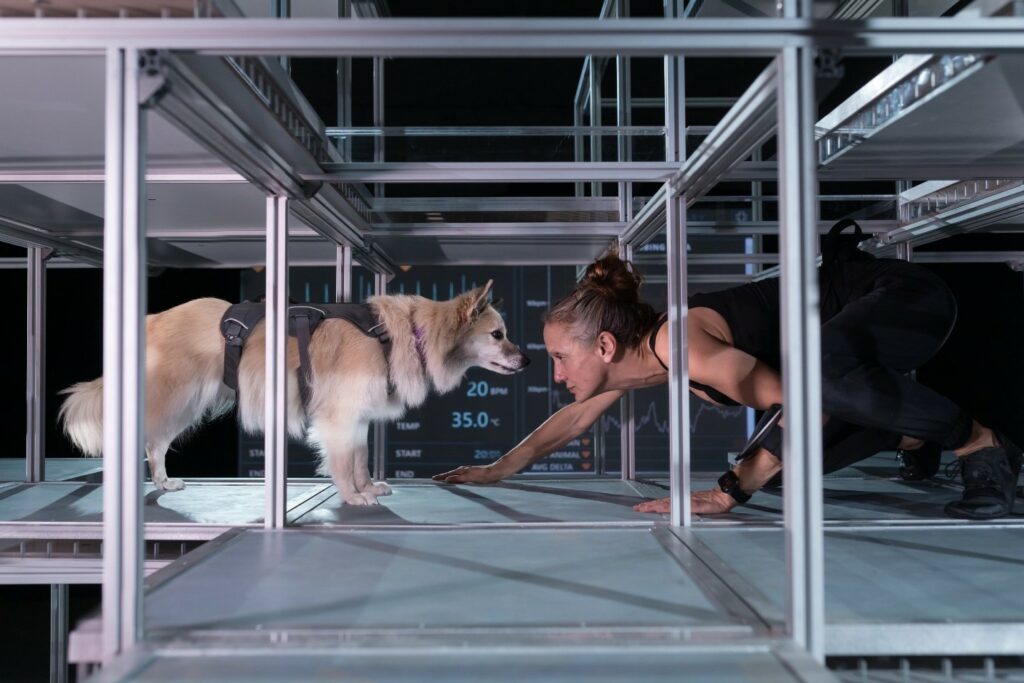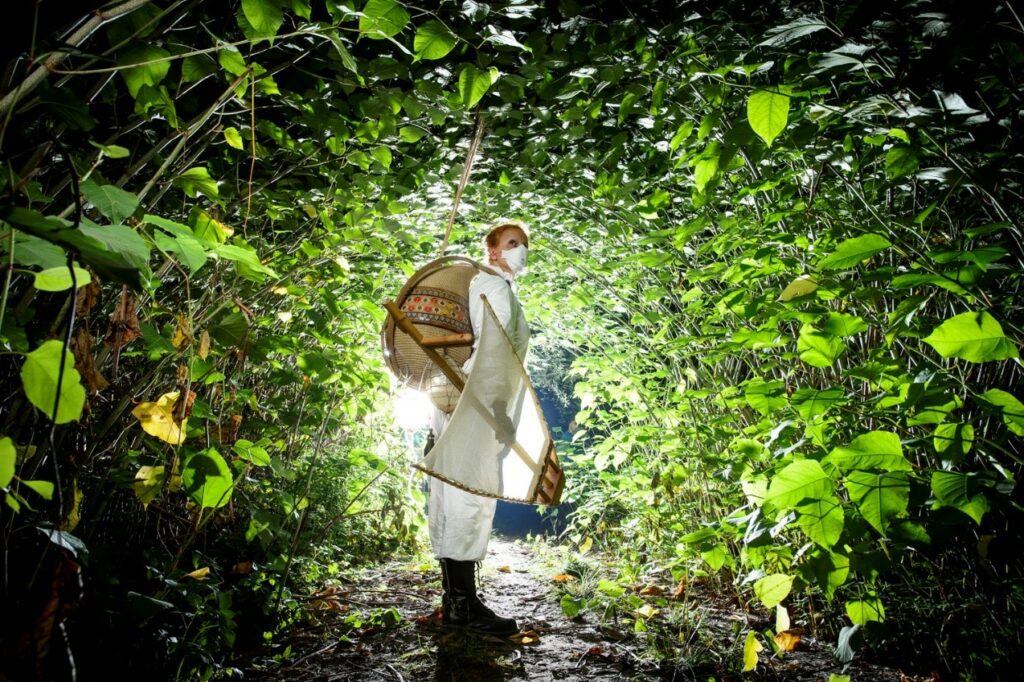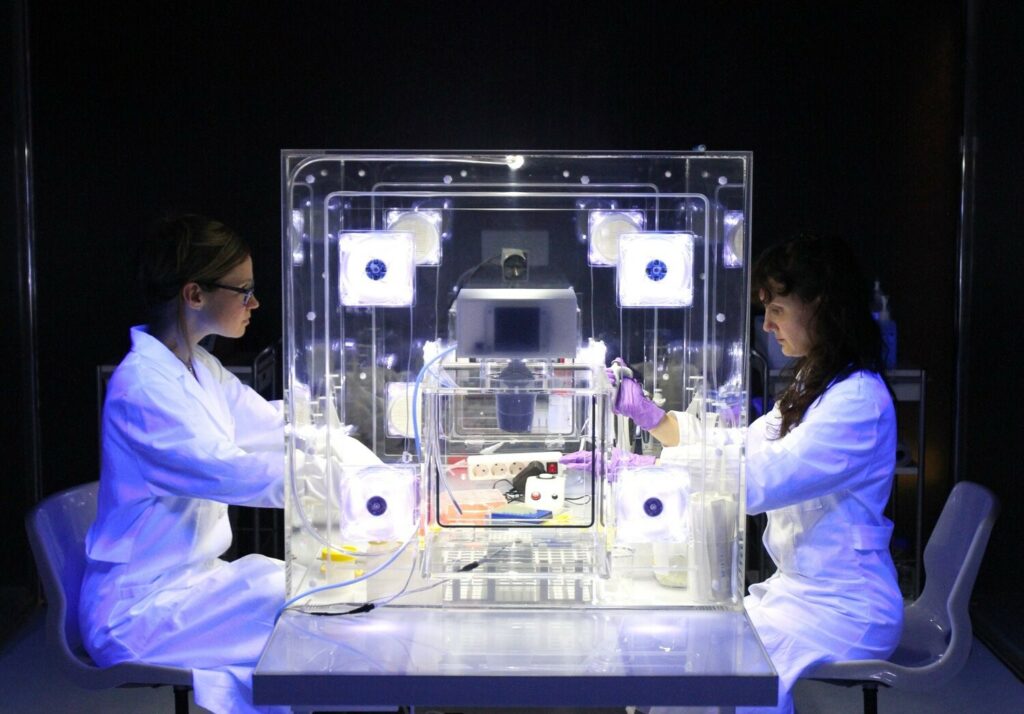This manifesto has been inspired by artist Maja Smrekar’s master class at IAAC, wherein she illuminated the myriad possibilities and variables that art can encompass when integrated with the digital tools available to today. The designer’s key intensions on “How Contemporary Art could incorporate the latest technology” as world is evolving with this bespoke technology.
The conventional art such as sculptures and colors are not much of a major attraction to the new world. The potential area that Maja envisioned was on how technology could be part of this contemporary art.
Our Manifesto:
In every epoch, art has served as the language of the soul, reflecting the essence of a society and serving as a conduit for the free expression of emotions. Today, the world is amidst an overwhelming revolution, where technology and artificial intelligence unveil new possibilities with each passing day.
As architects, we have inherently fostered a profound connection with art since the inception of our education, with some even regarding architecture as an art form in itself. This connection renders us more attuned to the contemporary manifestations of art. Like all disciplines, the technological revolution has profoundly impacted the field of architecture, ushering in new possibilities in design, construction, project execution, and beyond. Amidst this revolution, where does our artistic side reside?
This artistic facet, akin to all realms of our profession, has found itself in a realm of new possibilities. Emerging technologies in architecture, coupled with the sensitivity, passion, and education of the artist, have converged to generate artistic responses to these novel ways of transcending the architectural industry.
Art is one of the disciplines that makes us human, sensitizing us to events and situations. In a contemporary world inundated with complexity and information, art and architecture have found diverse avenues to navigate and reflect their reality. Presently, through the utilization of data science, computational design, and even physical fabrication tools, various artistic expressions emerge. Here, the artist’s sensibility is imprinted upon a set of parameters, allowing for the exploration of the spirit of an epoch and a discipline in a unique manner.
We inhabit a world where the artist, architect, engineer, or any other discipline plays a pivotal role in shaping the contemporary manifestation of art. Data, artificial intelligence, and industry infrastructure have paved the way for a deeper understanding of art within the realm of contemporary architecture.
In this manifesto, we assert the indispensable role of art in architecture, emphasizing the need for a symbiotic relationship between technology and human expression. As architects, we embrace this juncture of art and science, recognizing it as a catalyst for innovation and societal progress. Let us champion the integration of art into the very fabric of architectural practice, enriching our built environment with creativity, emotion, and meaning.
In conclusion, the artistic spirit in architecture thrives alongside technological advancements. Data, AI, and new tools empower architects to express themselves in innovative ways, shaping a future where art and technology work together to create a more meaningful built environment.
!brute_force

!brute_force is an art project that investigates how AI governs our lives through structured models of reality. It challenges the idea of a human-machine divide and explores the co-existence within a system driven by market forces and commodification.
The project aims to explores the potential for AI to transcend its deterministic role and create new forms of liberation from predefined models.
Key Components:
- Dystopian Microcosm: The installation resembles a 3D grid representing a serotonin molecule, referencing the human-dog evolutionary connection.
- Biofeedback Loop: Artist’s and dog’s physiological data are captured and fed to an AI, influencing the artist’s movements within the grid.
- Data Transparency: Physiological and AI data are publicly viewable, disrupting commercial health data practices.
- Soft Robotics Integration: Collaboration with Jonas Jørgensen in 2021 introduced soft robots programmed with performance data.
- Evolutionary Algorithm: Continuously updates the robots based on the !brute_force cloud data, aiming for “ontological and epistemological liberation” from hierarchical structures.
The project explores the potential for AI to transcend its deterministic role and create new forms of liberation from predefined models.
Survival Kit for the Anthropocene: A Critique of Modernity through Art

This art installation takes the form of a mobile survival kit, resembling a beehive and a Slovenian farm chest. It combines contemporary art with folklore, symbolizing the struggle for survival in the Anthropocene (human-impacted geological age).
Key Features:
- Hybrid Design: Blends a beehive (life symbol) with a farm chest (practicality), referencing traditional knowledge and adaptation.
- Folk Art Inspiration: Exterior adorned with images of invasive species, highlighting environmental disruption.
- Sustainability Focus: Materials include flax rope, pig bladders, acacia, and bamboo, promoting natural resources utilization.
- Multi-functionality: Converts between shade, fishnet, pitchfork, and crossbow, emphasizing resourcefulness.
- Disaster Preparedness: Drawers contain essentials like a radioactivity indicator, iodine tablets, and a protective mask.
Critique:
The artwork critiques:
- Disappearing Cultures: The mobile kit symbolizes vanishing local economies and traditions due to modern capitalism.
- Neoliberal Solutions: It criticizes the view of ecology as solely addressing climate change within the existing capitalist framework.
- Social Darwinism: It challenges the portrayal of climate change as a “survival of the fittest” scenario.
Conclusion:
The “Survival Kit for the Anthropocene” is a call for a shift from a solely capitalist approach to environmental solutions. It emphasizes the importance of traditional knowledge, local economies, and a sustainable relationship with nature for human survival in the face of ecological challenges.
Human Molecular Colonization Capacity: A Bioengineered critique of Capitalism

This project tackles the concept of wasted productivity within capitalism, referencing Karl Marx’s theory of declining profit rates due to labor exploitation through technological advancements.
Execution:
- Genetically Modified Microorganism: An artist’s gene is fused with a yeast gene to create a microorganism specifically designed to produce lactic acid (a common food additive).
- Bioengineered Yogurt: The microorganism is used to create yogurt, representing the end product of this “human molecular colonization.”
- Marketable Art Object: The yogurt is packaged in a designer container, blurring the lines between art and commodity.
Critique:
The project criticizes:
- Capitalist Desire: It highlights the insatiable nature of capitalist production, even resorting to metaphorical “cannibalism” to sustain itself.
- Consumer Entrapment: It showcases how corporations exploit both labor and consumer desire to fuel their growth.
- Malthusian vs. Marxian View: It contrasts Thomas Malthus’s idea of population pressure on resources with Marx’s view of capital creating pressure on the population to consume.
Social Darwinism Twist:
The project presents this exploitation as a “social Darwinism experience,” implying a “survival of the fittest” mentality within the capitalist food chain.
Overall conclusion:
The exploration of Maja Smrekar’s work has ignited a discussion on the vast potential of integrating technology into contemporary art. We, as architects who hold a deep connection to artistic expression, recognize the transformative power of this marriage.
The examples we’ve explored -! brute force’s exploration of AI governance, the Survival Kit for the Anthropocene’s critique of capitalism, and Human Molecular Colonization Capacity’s bioengineered commentary – all demonstrate the profound ways art can engage with pressing issues using the latest technologies.
We, as architects and artists, must embrace this convergence of art and science.
- Symbiosis between Technology and Human Expression: Technology is a powerful tool, but it should never replace artistic vision. We must find a harmonious balance between the two.
- Innovation and Societal Progress: This integration of art and technology should be a catalyst for pushing boundaries and creating a better future.
- Enriching the Built Environment: By integrating art into architecture, we can imbue our physical spaces with deeper meaning, emotion, and creativity.
The world is constantly evolving, and so should art and architecture. Let us seize the potential of this digital age to create a future where art and technology work together to shape a more meaningful and inspiring world.

